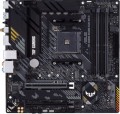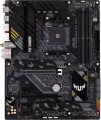Form factor
The form factor of the motherboard determines, first of all, its physical dimensions, and, accordingly, a number of parameters directly related to them: type of computer case, installation method, type of power connector, number of slots for additional boards (expansion slots), etc. At the moment, there are such main form factors of motherboards:
—
ATX. One of the most common form factors for PC motherboards. The standard size of such a board is 30.5x24.4 cm, it has up to 7 expansion slots and a 24-pin or (less often, in older models) 20-pin power connector.
—
Micro-ATX. A slightly reduced version of the ATX form factor, with more compact dimensions (usually 24.4x24.4 cm) and, accordingly, fewer places for peripherals — there are usually only two slots for "RAM", expansion slots — from two to four. Nevertheless, despite the limited size, such boards can be intended for quite powerful systems.
—
Mini-ITX. Motherboards of compact dimensions (17x17 cm). Designed for use primarily in small form factor computers (small form factor, SFF), in other words, compact PCs. According to the mounting specifications and the location of connectors and slots, they are compatible with ATX standard cases. They usually have one expansion slot.
—
mini-STX. Another representative of compact form factors, assuming a boar
...d size of 140x147 mm. Thus, the overall size is almost a third smaller than mini-ITX. At the same time, such motherboards often have seats for fairly powerful processors (for example, the LGA 1151 socket for Intel Core chips) and are made based on the corresponding TDP values. But expansion slots, usually, are absent.
— micro DTX. A relatively new compact form factor, which is not common, mainly among rather specific motherboards — in particular, models designed for cases in the PIO form factor. This form factor is characterized by a very small size and weight and allows you to mount the case directly behind the monitor, on a standard VESA mount. One of the features of "motherboards" for such systems is that the graphics card is installed along the board, and not perpendicularly — accordingly, the PCI-E 16x connector (see below) has a non-standard location. At the same time, micro-DTX boards are similar in terms of fasteners to microATX and can be used in cases of the corresponding form factor (except that additional equipment may be required for the correct installation of a graphics card). The standard size of such a board is 170 x 170 mm, similar to mini-ITX.
— mini DTX. An intermediate format between the microDTX described above and the original DTX; sometimes also described as an extended mini-ITX version. It has a standard size of 170 x 203 mm and can be equipped with two expansion slots (mini-ITX and mini-DTX have one such slot); it is completely similar in application — it is intended mainly for compact cases, in particular, HTPC computers.
— XL-ATX. Larger version of the ATX form factor. While not yet a common standard, size options include 32.5x24.4cm with 8 expansion slots and 34.3x26.2cm with up to 9 expansion slots.
— Thin mini-ITX. A “thin” version of the reduced mini-ITX form factor described above: according to the official specification, the total thickness of the thin mini-ITX board should not exceed 25 mm. Also designed for the most miniature computers — in particular, HTPC.
— E-ATX. The letter E in the name of this form factor stands for "Extended" — extended. True to its name, E-ATX is another enlarged version of ATX using 30.5x33cm boards.
— EEB. Full name SSI EEB. The form factor used in server systems (see “By direction”) provides a board size of 30.5x33 cm.
— CEB. The full name is SSI CEB. Another form factor of "server" motherboards. In fact, it is a narrower version of the EEB described above, with a width reduced to 25.9 cm (with the same height of 30.5 cm).
— flex-ATX. One of the compact variations of ATX, which provides board dimensions of less than 229x191 mm, as well as less than 3 expansion slots. At the same time, in terms of the location of the mounting holes, this standard is identical to microATX; in fact, it was developed as a potential replacement for the latter, but for a number of reasons it did not receive much distribution, although it continues to be produced.
— Non-standard (Custom). The name Proprietary is also used. Motherboards that do not conform to standard form factors and are designed for cases of special sizes (usually branded ones).LED lighting
The presence of its own LED
backlight on the motherboard. This feature does not affect the functionality of the "motherboard", but gives it an unusual appearance. Therefore, it hardly makes sense for an ordinary user to specifically look for such a model (a
motherboard without backlighting is enough for him), but for modding lovers, backlighting can be very useful.
LED backlighting can take the form of individual lights or LED strips, come in different colours (sometimes with a choice of colours) and support additional effects — flashing, flickering, synchronization with other components (see "Lightning synchronization"), etc. Specific features depend on the motherboard model.
Lighting sync
Synchronization technology provided in the board with LED backlight (see above).
Synchronization itself allows you to "match" the backlight of the motherboard with the backlight of other system components — cases, video cards, keyboards, mice, etc. Thanks to this matching, all components can change colour synchronously, turn on / off at the same time, etc. Specific features the operation of such backlighting depends on the synchronization technology used, and, usually, each manufacturer has its own (Mystic Light Sync for MSI, RGB Fusion for Gigabyte, etc.). The compatibility of the components also depends on this: they must all support the same technology. So the easiest way to achieve backlight compatibility is to collect components from the same manufacturer.
Size (HxW)
Motherboard dimensions in height and width. It is assumed that the traditional placement of motherboards is vertical, so in this case one of the dimensions is called not the length, but the height.
Motherboard sizes are largely determined by their form factors (see above), however, the size of a particular motherboard may differ slightly from the standard adopted for this form factor. In addition, it is usually easier to clarify the dimensions according to the characteristics of a particular motherboard than to look for or remember general information on the form factor. Therefore, size data can be given even for models that fully comply with the standard.
The third dimension — thickness — is considered less important for a number of reasons, so it is often omitted.
XMP
The ability of the motherboard to work with RAM modules that support
XMP (Extreme Memory Profiles) technology. This technology was developed by Intel; it is used in motherboards and RAM blocks and only works if both of these system components are XMP compliant. A similar technology from AMD is called AMP.
The main function of XMP is to facilitate system overclocking (“overclocking”): special overclocking profiles are “sewn” into the memory with this technology, and if desired, the user can only select one of these profiles without resorting to complex configuration procedures. This is not only easier, but also safer: every profile added to the bar is tested for stability.
SATA 3 (6Gbps)
Number of
SATA 3 ports on the motherboard.
SATA is now the standard interface for connecting internal drives (mainly HDDs) and optical drives. One device is connected to one such connector, so the number of SATA ports corresponds to the number of internal drives / drives that can be connected to the motherboard through such an interface. A large number (
6 SATA ports and more) is necessary in case of active use of several hard drives and other peripherals. For domestic use, 4 is enough. SATA 3, as the name suggests, is the third version of this interface, operating at a total speed of about 6 Gbps; the useful speed, taking into account the redundancy of the transmitted data, is about 4.8 Mbps (600 MB / s) — that is, twice as much as in SATA 2.
Note that different SATA standards are quite compatible with each other in both directions: older drives can be connected to newer ports, and vice versa. The only thing is that the data transfer rate will be limited by the capabilities of the slower version, and in some cases it may be necessary to reconfigure the drives with hardware (switches, jumpers) or software. It is also worth saying that SATA 3 is the newest and most advanced variation of SATA today, but the capabilities of this standard are not enough to unlock the full potential of high-speed SSDs. Therefore, SATA 3 is mainly used for hard drives and low-cost SSDs, faster drives are conn
...ected to specially designed connectors like M.2 or U.2 (see below).1x PCI-E slots
Number of PCI-E (PCI-Express) 1x slots installed on the motherboard. There are
motherboards for 1 PCI-E 1x slot,
2 PCI-E 1x slots,
3 PCI-E 1x ports and even more.
The PCI Express bus is used to connect various expansion cards — network and sound cards, video adapters, TV tuners and even SSD drives. The number in the name indicates the number of PCI-E lines (data transfer channels) supported by this slot; the more lines, the higher the throughput. Accordingly, PCI-E 1x is the basic, slowest version of this interface. The data transfer rate for such slots depends on the PCI-E version (see "PCI Express Support"): in particular, it is slightly less than 1 GB / s for version 3.0 and slightly less than 2 GB / s for 4.0.
Separately, we note that the general rule for PCI-E is as follows: the board must be connected to a slot with the same or more lines. Thus, only single-lane boards will be guaranteed to be compatible with PCI-E 1x.
CrossFire (AMD)
Motherboard support for
AMD's Crossfire technology.
This technology allows you to connect several separate AMD graphics cards to a PC at once and combine their computing power, respectively increasing the system's graphics performance in specific tasks. Accordingly, this feature means that the "motherboard" is equipped with at least two slots for video cards — PCI-E 16x; in general, Crossfire allows up to 4 separate adapters to be connected.
Such functionality is especially important for demanding games and "heavy" tasks like 3D rendering. However, note that in order to use several video cards, this possibility must also be provided in the application running on the computer. So in some cases, one powerful video adapter is more preferable than several relatively simple ones with the same total amount of VRAM.
A similar technology from NVIDIA is called SLI (see below). Crossfire differs from it mainly in three points: the ability to combine video adapters with different models of graphics processors (the main thing is that they are built on the same architecture), no need for additional cables or bridges (video cards interact directly via the PCI-E bus) and somewhat lower cost (allowing the use of this technology even in low-cost "motherboards"). Thanks to the latter, almost all motherboards with SLI also support Crossfire, but not vice versa.
Thunderbolt AIC connector
5-pin connector that allows you to connect an expansion card. It, in turn, provides high-speed data exchange (up to 40 Gbps), the ability to connect external monitors, high-speed charging of compatible devices, etc.

